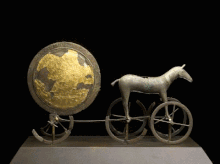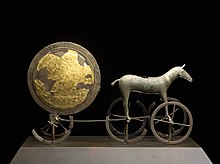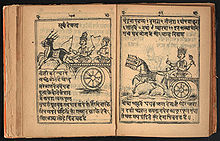Trundholm sun chariot
| Trundholm sun chariot | |
|---|---|
 | |
| Material | Bronze |
| Created | Nordic Bronze Age, c. 1500-1300 BC |
| Discovered | 1902 Odsherred, Denmark |
| Present location | National Museum of Denmark, Copenhagen |
The Trundholm sun chariot (
The sculpture was discovered with no accompanying objects in 1902 in a
Description

The horse stands on a bronze rod supported by four wheels. The rod below the horse is connected to the disk, which is supported by two wheels. All of the wheels have four spokes. The artifact was cast in the lost wax method. The whole object is approximately 54 cm × 35 cm × 29 cm (21 in × 14 in × 11 in) in size (width, height, depth).[3][1] Aspects of the decoration suggest a Danubian influence in the object, although it was produced locally.[4][5]


The disk has a diameter of approximately 25 cm (9.8 in). It is gilded on one side only, the right-hand side (when looking at the horse from behind). It consists of two bronze disks that are joined by an outer bronze ring, with a thin sheet of gold applied to one face. The disks were then decorated with punches and gravers with zones of motifs of concentric circles, with bands of zig-zag decoration between borders. The gold side has an extra outer zone which may represent rays, and also a zone with concentric circles linked by looping bands that "instead of flowing in one direction, progress like the steps of the dance, twice forward and once back". The main features of the horse are also highly decorated.[6]
The two sides of the disk have been interpreted as an indication of a belief that the Sun is drawn across the heavens from East to West during the day, presenting its bright side to the Earth and returns from West to East during the night, when the dark side is being presented to the Earth. A continuation around a globe would have the same result. It is thought that the chariot was pulled around during religious rituals to demonstrate the motion of the Sun in the heavens.[7]
Two similar discs have been found in Ireland: the Lattoon gold disc[8][9] and the bronze Cooke disc, the latter dated to c. 1500– 1300 BC. The Cooke disc has similar fittings to the Trundholm chariot, suggesting that it was also originally connected to a sun horse and mounted on wheels.[10]
Date
The sculpture is dated to about 1400 BC,[3] or Montellius period II (c. 1500-1300 BC).[11]
Evidence for horse-drawn chariots first appears in Scandinavia around 1700 BC, in the form of petroglyphs, chariot bits and whip handles.[12][13][14]
Calendar
Some authors have suggested that the decoration on the disc numerically encodes a calendar, or calendrical information.[15][16] The archaeologist Christoph Sommerfeld argues that both sides of the disc encode knowledge of the 19-year lunisolar Metonic cycle.[17] The Metonic cycle is also thought to be encoded on the later Berlin Gold Hat, dating from c. 1000 BC.[18][19]
Sun chariot in Indo-European mythology and religions
Norse mythology
The chariot has been interpreted as a possible
, the personification of day, across the sky.Celtic Pantheon
The sky god Taranis is typically depicted with the attribute of a spoked wheel.

Hindu scriptures
The
10. Her spirit was the bridal car; the covering thereof was heaven: Bright were both Steeds that drew it when Surya approached her husband's home.
11. Thy Steeds were steady, kept in place by holy verse and Sama-hymn: All car were thy two chariot wheels: thy path was tremulous in the sky,
12. Clean, as thou wentest, were thy wheels, wind was the axle fastened there. Surya, proceeding to her Lord, mounted a spirit-fashioned car.[21]
Greek mythology
In
See also
- Egtved Girl
- Golden hat
- Håga Kurgan
- Nebra skydisk
- Phaëton
- Sól (sun)
- Sun worship
- The King's Grave
- Urnfield culture
- Cult Wagon of Strettweg
References
- ^ a b "Trundholm Sun Chariot". CWA 80. Retrieved 5 September 2022.
- ^ "1000-krone banknote".
- ^ a b "The Sun Chariot". Nationalmuseet. Retrieved 16 September 2020.
- from the original on 22 July 2022. Retrieved 30 November 2020.
- ^ "The Sun Chariot". Nationalmuseet. Retrieved 16 September 2020.
- ^ Sandars, 184–185
- ^ Sandars, 184; see also Nationalmuseet video
- ^ Leonard, Katharine (2014). Ritual in Late Bronze Age Ireland - Material Culture, Practices, Landscape Setting and Social Context (PDF) (PhD). University of Galway. p. 95.
- ^ "Photo of the Lattoon disc". British Archaeology Magazine. 2019.
- ^ Mathias, Florent; Wilkin, Neil (2019). "The Sun also Rises". British Archaeology. 164: 52–57.
- ISBN 9780521843638.
- ISBN 978-3-7749-4074-1. Archivedfrom the original on 7 April 2023. Retrieved 26 September 2022.
- from the original on 22 July 2022. Retrieved 30 November 2020.
- ISBN 978-1-84217-998-7.
- .
- ^ Randsborg, Klavs (2006). "Calendars of the Bronze Age". Acta Archaeologica. 77: 62–90.
- .
- ^ "Golden Ceremonial Hat ("Berlin Gold Hat")". Neues Museum Berlin.
- .
- ISBN 0-19-515382-0.
- ^ Mandala 10/Hymn 85
- ^ Madanjeet Singh, Ahmad Hasan Dani (1993), The Sun: Symbol of Power and Life, H.N. Abrams, p. 293, ISBN 978081093838.
Sources
- Sandars, Nancy K., Prehistoric Art in Europe, Penguin (Pelican, now Yale, History of Art), 1968 (nb 1st edn.)
External links
- Reconstructing the Trundholm Sun Chariot Archived 11 October 2008 at the Wayback Machine, Anders Söderberg, Sweden, 2002. Söderberg demonstrates how part of the chariot might have been made using the lost-wax method.
- Götter und Helden in der Bronzezeit: Europa im Zeitalter des Odysseus, exhibition, Bonn. 1999. Catalogue introduction, wall panel information: (.doc format)
